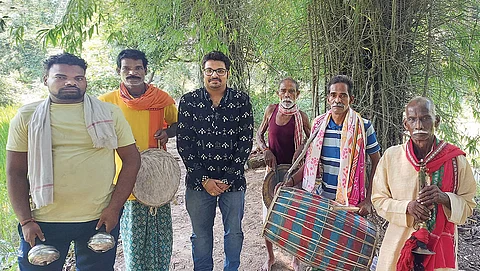

Every week, after his classes at Yuvodaya College in Balangir, Odisha, zoology lecturer Rajat Kumar Panigrahi gets on his motorcycle and takes off for villages as far as hundreds of kilometres away. Sometimes, he is accompanied by his cousin, Satyanarayan Panigrahi, and carries a video camera. His mission is simple: to document traditional art forms of Odisha before they are lost in obscurity.
Since 2012, Rajat, a native of Raj Komna village in Nuapada district, has travelled across Odisha and Chhattisgarh to learn about folk art in different villages and communities. So far, he has visited more than 1,500 villages and connected with about 20,000 artists. “I have learnt about folk art, music, dance and instrument-making practices of indigenous tribes such as the Dongria Kondh, Bonda, Chakotia Bhunjia and Kishan communities. I have also met prominent artists of these communities,” he says. Rajat documents the people's skills and lives through videos on a YouTube channel, “Matir Kala”. Since 2017, he has uploaded nearly 100 videos with help from his cousin and a friend, Ganesh Pradhan. He also encourages artists to hold demonstrations for younger generations, to spark interest in keeping the practices alive.
Rajat discovered his passion for folk art forms more than a decade ago, while still in college. Since 1590, his village holds an annual festival, Chhatar Jatra, during Dusshera. He grew curious about similar traditions and visited other villages to learn more. “As skilled as the artists were, their financial conditions were not good. They also do not have access to many welfare or support schemes. Around 2014, after I began to work as a teacher, I started to help them financially whenever possible,” he says.
The Matir Kala videos also help. “My family has been making and selling instruments such as mridang and dholak (types of drums) since my grandfather’s time. But over the past few years, demand dropped,” says Shyama Mahanand of Kurul village in Balangir district. “Rajat has made two videos of my father and I making the instruments, which reignited interest. During the Kartik month last year (it occurs between October and November), we sold Rs 50,000 worth of instruments,” he says.
While the videos are encouraging, lack of government support remains a challenge, says Mahanand. “Sourcing traditional materials such as cowhide has become difficult, as we do not always get permission from authorities to use it,” he says. Rajat, who has been awarded by non-profits and cultural organisations such as Juhar Parivar and Dalkhai Foundation, Bengaluru for his documentation of folk practices, hopes to spread more awareness and facilitate action to address the artists' challenges.
This article was originally published in the September 1-15, 2024 print edition of Down To Earth